- Unity User Manual (2019.1)
- 时间轴
- Timeline window
- Clip Edit modes and the Clips view
- Easing-in and easing-out clips
Easing-in and easing-out clips
Ease-in and ease-out a clip to create a smooth transition between a clip and its surrounding gaps. To create an ease-in or ease-out transition, select a clip and, in the Inspector window, set either the Ease In Duration or the Ease Out Duration.
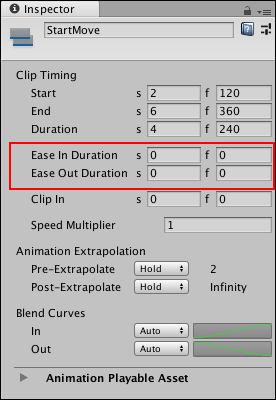
Ease-in and ease-out transitions create different effects, depending on the track:
On an Animation track or an Animation Override track, ease-in to an Animation clip to create a smooth transition between the animation in the gap before the clip and the Animation clip. Ease-out of an Animation clip to create a smooth transition between the Animation clip and the animation in the gap after the clip. For information on the factors that determine what animation occurs in the gap before and after an Animation clip, see Setting gap extrapolation.
On an Audio track, ease-in to an Audio clip to fade in the volume of the audio waveform. Ease-out of an Audio clip to fade out the volume of the audio waveform specified by the Audio clip.
On a Playable track, ease-In to a Playable clip to fade in the effect or script in the Playable clip. Ease-out of a Playable clip to fade out the effect or script in the Playable clip.
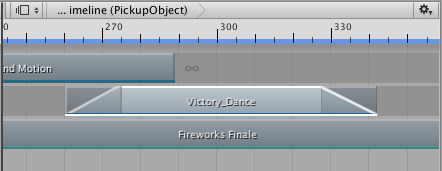
Although the Clips view represents an ease-in or ease-out transition as a single linear curve, every ease-in or ease-out transition is actually set to a gradually easing-in or easing-out curve by default. To change the shape of either the ease-in curve (labelled In) or the ease-out (labelled Out) curve, use the Blend Curves in the Inspector window.
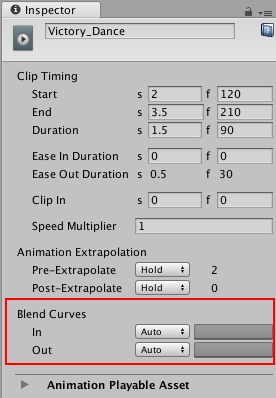
Note that the Blend Curves might affect the blend area used for blending between two clips. The Ease In Duration and Ease Out Duration properties indicate whether the Blend Curves affect an ease-in or ease-out transition, or a blend. For example, If the Ease Out Duration is editable, then the Blend Out curve (labelled Out) affects the curve used by an ease-out transition. If the Ease Out Duration is not editable, then the Blend Out curve (labelled Out) affects the outgoing clip in a blend between two clips.
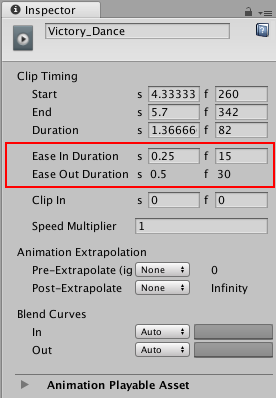
To customize either the ease-in or ease-out transition, use the drop-down menu to switch from Auto to Manual. With Manual selected, the Inspector window shows a preview of the blend curve. Click the curve preview to open the Curve Editor below the Inspector window.
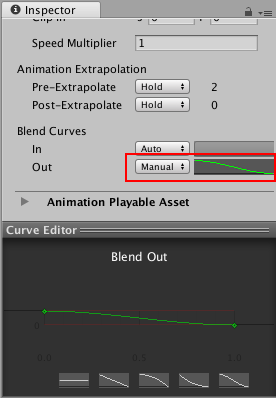
曲线编辑器 (Curve Editor) 与混合剪辑时用于自定义混合曲线形状的编辑器相同。
When creating an ease-in or an ease-out transition with Animation clips, the Animation clip blends between its gaps and the Animation clip. The following factors affect the values of animated properties in the gaps surrounding an Animation clip:
动画剪辑的和同一轨道上其他动画剪辑的前外推 (pre-extrapolate) 和后外推 (post-extrapolate) 设置。
绑定到同一游戏对象的其他动画轨道上的动画剪辑。
The position or animation of the GameObject in the Scene, outside the Timeline Asset.
Gap extrapolation and easing clips
To successfully ease-in or ease-out an Animation clip, gap extrapolation must not be set based on the Animation clip being eased-in or eased-out. Gap extrapolation must either be set to None or set by another Animation clip.
For example, the following ease-in transition has no effect because the Pre-Extrapolate for the Victory_Dance clip is set to Hold. This means that the ease-in creates a transition between the first frame of the Animation clip and the rest of the Animation clip.
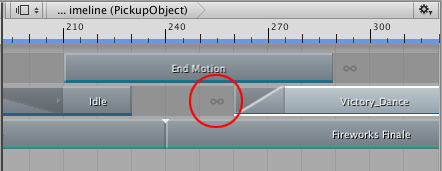

Overriding Animation tracks with ease-in and ease-out transitions
Use two Animation tracks bound to the same GameObject to create a smooth transition between two Animation clips.
For example, if two Animation tracks are bound to the same GameObject and a clip on the second track contains an ease-in transition, the ease-in transition creates a smooth transition between the animation on the previous track and the animation on the second track.
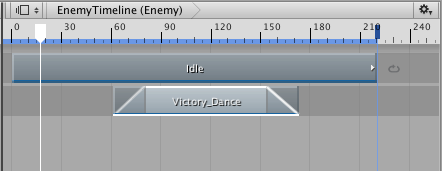
In this example, the Animation clip on the first track is a repeated idle cycle where the humanoid GameObject stands still. The Animation clip in the second track eases-in the Victory_Dance motion and eases-out to return back to the idle cycle
To successfully override animation on a previous track, the gap extrapolation for the second track must be set to None so that the animation data in the gap is taken from the previous track bound to the same GameObject. The ease-in and ease-out transitions use this animation data.
- 2019–08–20 页面已发布并只进行了有限的编辑审查